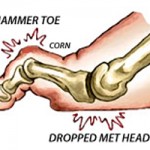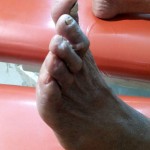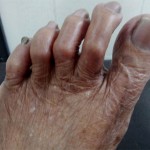Toe Deformities
Condition and Causes
A hammer toe or contracted toe is a deformity of the second, third or fourth toes. In this condition, the toe is bent at the middle joint, so that it resembles a hammer.
Mallet toe is a similar condition affecting the distal joint.
Claw toe is another similar condition, with clawing of toes. Claw toe can affect the second, third, fourth, or fifth toes.
The most common cause of hammer toe is the use of improper footwear such as high heels or ill-fitting shoes.
Initially, hammer toes are flexible and can be corrected with simple measures but, if left untreated, they can become fixed and require surgery.
People with hammer toe may have corns or calluses on the top of the middle joint of the toe or on the tip of the toe. They may also feel pain in their toes or feet and have difficulty finding comfortable shoes.
Hammer toe most frequently results from wearing poorly fitting shoes that can force the toe into a bent position, such as excessively high heels or shoes that are too short or narrow for the foot. Having the toes bent for long periods of time can cause the muscles in them to shorten, resulting in the hammer toe deformity. This is often found in conjunction with bunions or other foot problems. It can also be caused by muscle, nerve, or joint damage resulting from conditions such as osteoarthritis, rheumatoid arthritis, stroke or diabetes.
Symptoms
A bent middle joint of the foot is characteristic of most hammer toes, generally making it painful to walk or wear closed footwear for an extended period of time. Often associated with hammer toes is the development of corns on the top of the toe and a callus along the sole.
Prevention
Wearing correct fitting supportive footwear with wide toe box with extra depth will help to prevent the development of complications of hammer toes.
Possible Treatment
In many cases, conservative treatment consisting of physical therapy and new shoes with soft, spacious toe boxes is enough to resolve the condition, while in more severe or long standing cases surgery may be necessary to correct the deformity. You may also be prescribed some toe exercises that can be done at home to stretch and strengthen the muscles.




